The main fiesta of Firgas is the one organised in honour of its patron saint: the Fiestas de San Roque. The main days are August 15th, with the procession, and August 16th, the day of the patron saint San Roque. The people of Firgas organise a variety of cultural and public events, including a large cattle show.
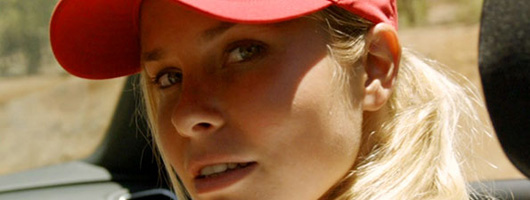
There is also a tradition in the municipality which coincides with these fiestas, known as the ‘Traída del Palo’ (the Bringing of the Pole), where the locals carry a pole from the mountain of Firgas to the town centre, passing through several streets to the accompaniment of the band. When they arrive in Firgas, all the participants raise the pole, which is then used for raising the flag of the municipality and becomes the central point of all the Fiestas.
The religious festivities of Firgas also include the Fiestas de San Luis Gonzaga, on June 21st, where the locals go through the streets holding branches and are accompanied by giants and figures with large heads, to the rhythm of the band. During the Fiestas of San Luis Gonzaga, as well as those of San Roque, there is a traditional ‘Cart race’, where the carts are made by the participants and must follow a route through several streets of the town.
On August 18th 1480 Pedro de Vera first landed at the port of La Isleta, accompanied by a number of archers, including Tomás Rodríguez de Palenzuela who was originally from Burgos and had experience fighting against the Arabs.
After the dividing of the land and water resources granted by the Catholic Monarchs, Tomás Rodríguez de Palenzuela received land in the area of Arucas, and became established in a place known as Afurgad, as it was called by the inhabitants of the place. This seems to have a double meaning: either "high place" or "crossroads". What is certain is that this was where work began on cutting down the woods, building dwellings, beginning the growing of sugar cane and building a sugar mill and a chapel.
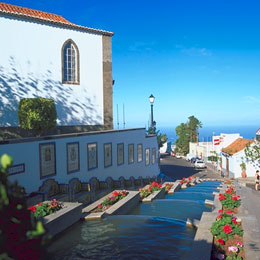
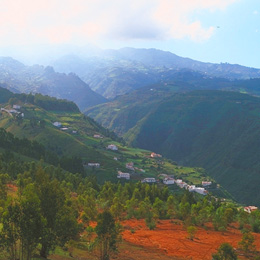
Thus life in this area began, with an intermingling of those who arrived from mainland Spain and the native inhabitants, with a great deal of activity being undertaken. In the sixteenth century the name Firgas arose from Afurgad, although there is no explanation for this change of name.
The chapel had its own land, and further donations covered its requirements, but the distance from the parish church on which it depended, San Juan Bautista in Arucas, was a problem for the inhabitants, who did not have a priest on a permanent basis. Because of this, a meeting of residents in 1613 requested from Don Pedro Espino de Brito, archdeacon of the Canary Islands and Vicar-general of the Bishopric, to grant a licence to the Dominican Order of Preachers to found a convent which they would support with donations.
In an Edict of November 27th 1613 this licence was granted and until 1836 the Convent of San Juan de Ortega formed part of the history of Firgas and of Gran Canaria.
By 1616 there was a prosperous Dominican convent in existence, located in what is now the square Plaza de San Roque, which encouraged devotion to this Saint, the patron of the town. The convent was closed in 1835 with Mendizábal’s sale of church lands, and its walls are now part of the present-day Parish Church and Presbytery.
That very same year (1835), the village of Firgas separates from Arucas and becomes an independent Municipality.
The town of Firgas is 28 kilometres from the capital of the island. It has a surface area of 15.77 square kilometres and is at an altitude of 465 metres above sea level.
It is a municipality characteristic of the midlands of the North of Gran Canaria, and in geographical terms it is the smallest of the whole island.
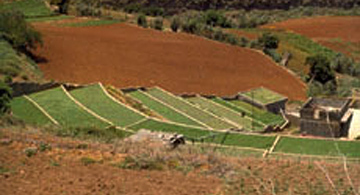
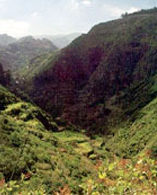
In the east and west it is bordered by the municipalities of Arucas and Moya, and in the south by Teror and Valleseco. Its rectangular shape of high relief is characterised by areas of long narrow ridges which, in turn, are crossed by a dense, complex network of ravines.
A special feature of the geography of this area is the finding of points of very recent volcanic emissions in the regions of la Montaña de Firgas, at 650 metres, in la Caldera de Firgas and in el Pico de Osorio.
A large part of the municipality is located within the Doramas Rural Park, catalogued as a Protected Natural Area, where you can discover the Special Natural Reserve of Azuaje. Visitors to Firgas can therefore enjoy areas of outstanding natural and rural beauty in the municipality.
Firgas has traditionally been an agricultural and stock-raising municipality, involved in particular with banana crops, in the coastal area, and potato, corn and watercress crops in the midlands, as well as the raising of cattle and goats. However, the main economic impulse of Firgas is in the exploitation of its water resources, which have made the municipality known both locally and nationally. In fact, the Mineral Water bottling plant, located in el barranco de Las Madres, is the industry with the largest number of employees.
Other industries which provide work for the labour force include flour and gofio mills, automobile repair workshops, panel beating and painting workshops, bakeries, supermarkets, general food stores, confectioner’s and carpenter’s shops.